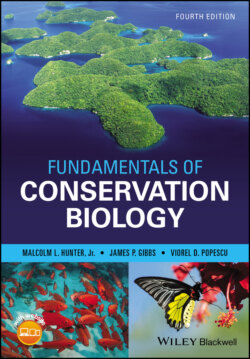Читать книгу Fundamentals of Conservation Biology - Malcolm L. Hunter Jr. - Страница 30
Structure and Function
ОглавлениеThe definition of biodiversity provided above emphasizes structure – forms of life and levels of organization – but sometimes ecological and evolutionary functions or processes are also included in a definition of biodiversity. For example, The Wildlife Society (1993) defined biodiversity as “the richness, abundance, and variability of plant and animal species and communities and the ecological processes that link them with one another and with soil, air, and water” (emphasis added).
The diversity of ecological functions is enormous. First, each of the Earth's millions of species interacts with other species through ecological processes such as competition, predation, parasitism, mutualism, and others. To take a close example, consider the staggering array of interactions between our human bodies and the more than 10,000 species of microorganisms living in or on us, each also interacting with one another (Huttenhower et al. 2012). Second, every species interacts with its physical environment through processes that exchange energy and elements between the living and nonliving world such as photosynthesis, biogeochemical cycling, and respiration. All of these functional interactions must total in the billions. The diversity of evolutionary functions is even more complex. It includes all these ecological processes because they are key elements of the conditions under which individuals survive and reproduce or do not (that is, natural selection), in addition to processes such as genetic mutation that shape each species’ genetic diversity.
Functional biodiversity is clearly important. For example, a management plan designed to keep an ecosystem intact will almost certainly fail in the long run unless the processes of evolution, especially natural selection, continue, allowing the species that comprise the ecosystem to adapt to a changing environment. Sometimes, focusing on a functional characteristic, for example, the fire regime of a grassland rather than the species that comprise the grassland (Fuhlendorf et al. 2012), is the most efficient way to maintain biodiversity of an ecosystem. Nevertheless, conservation biologists usually focus on maintaining structural biodiversity rather than functional biodiversity for two reasons. First, maintaining structural biodiversity is usually more straightforward because it is easier to inventory and protect species than their interactions with one another. Second, if structural diversity is successfully maintained, functional biodiversity will probably be maintained as well. If we can maintain a species of orchid and its primary insect pollinator together in the same ecosystem, then we will almost certainly have a pollination interaction between the two. Similarly, if we can maintain the orchid’s genetic diversity, we will probably have orchid evolution. The converse is not necessarily true. It is easy to think of circumstances where some major ecological processes are maintained, but structural diversity is severely degraded. For example, many of the forests of Puerto Rico are dominated by exotic trees that have largely replaced the native species, but they still perform as forests in terms of photosynthesis, biogeochemical cycling, and hydrologic processes (Lugo 2004).
In short, both the structural and functional aspects of biodiversity are important; however, if genetic, species, and ecosystem diversity are successfully maintained, then ecological and evolutionary processes will probably be maintained as well.
